Detailed Analysis of Human Reproduction, Growth, and Development
VerifiedAdded on 2023/06/14
|12
|2852
|96
Report
AI Summary
This report provides a detailed overview of human reproduction, growth, and development, beginning with the structure and function of the male and female reproductive systems, including the roles of organs such as the penis, scrotum, testes, epididymis, ovaries, uterus, and fallopian tubes. It explores the function of reproductive system that is related between the sexually mature that include male and female. The report further examines the roles of various hormones, such as follicle-stimulating hormone (FSH), luteinizing hormone (LH), human chorionic gonadotropin (hCG), prolactin, oxytocin, and relaxin, during key developmental stages like gametogenesis, puberty, pregnancy, and menopause. The processes and sequence of events in fertilization, implantation, fetal development, and childbirth are also discussed, highlighting the critical stages and hormonal influences. Finally, the report elucidates the placental function during pregnancy, emphasizing its role in providing oxygen and nutrients to the developing fetus and removing waste products. Desklib offers a wealth of similar solved assignments and study resources for students.
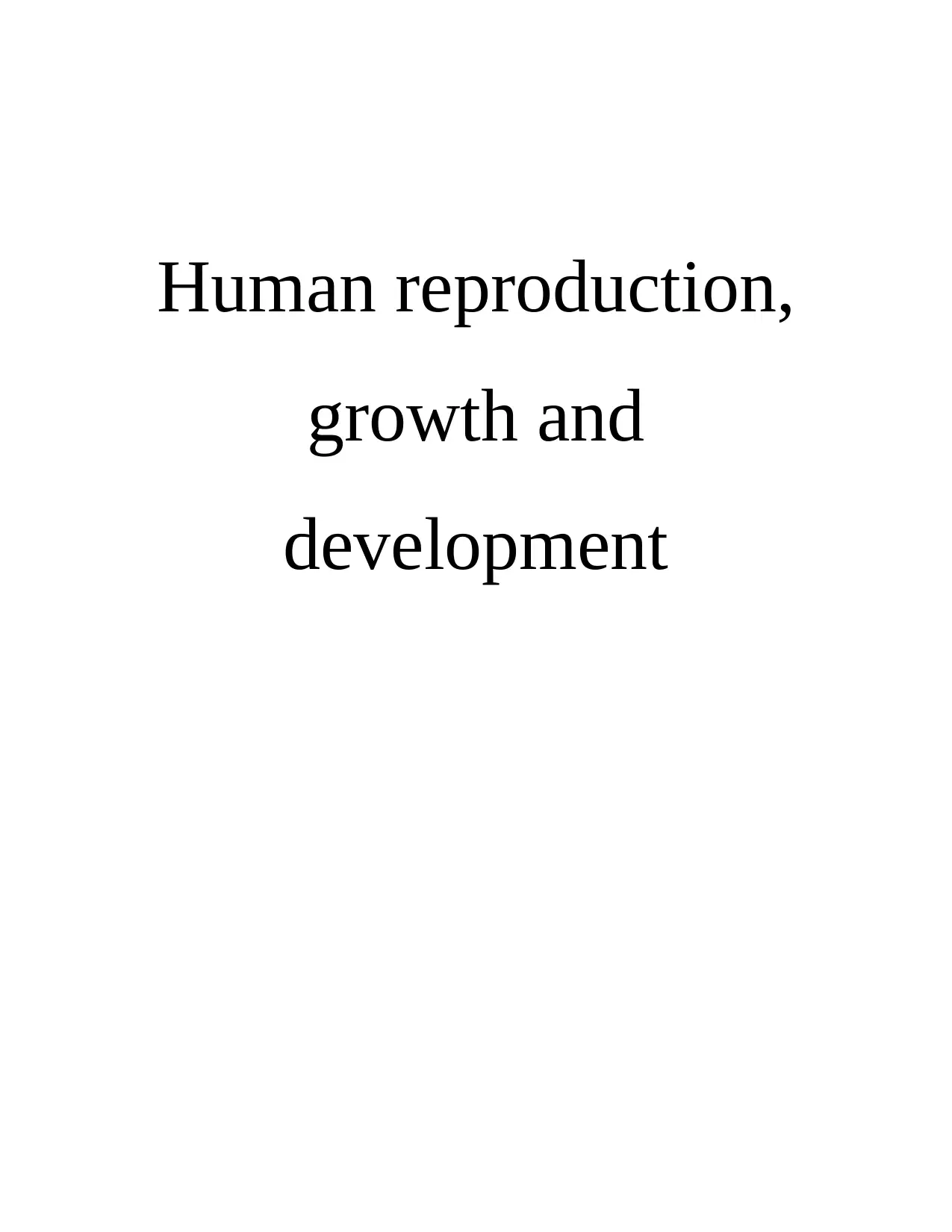
Human reproduction,
growth and
development
growth and
development
Paraphrase This Document
Need a fresh take? Get an instant paraphrase of this document with our AI Paraphraser
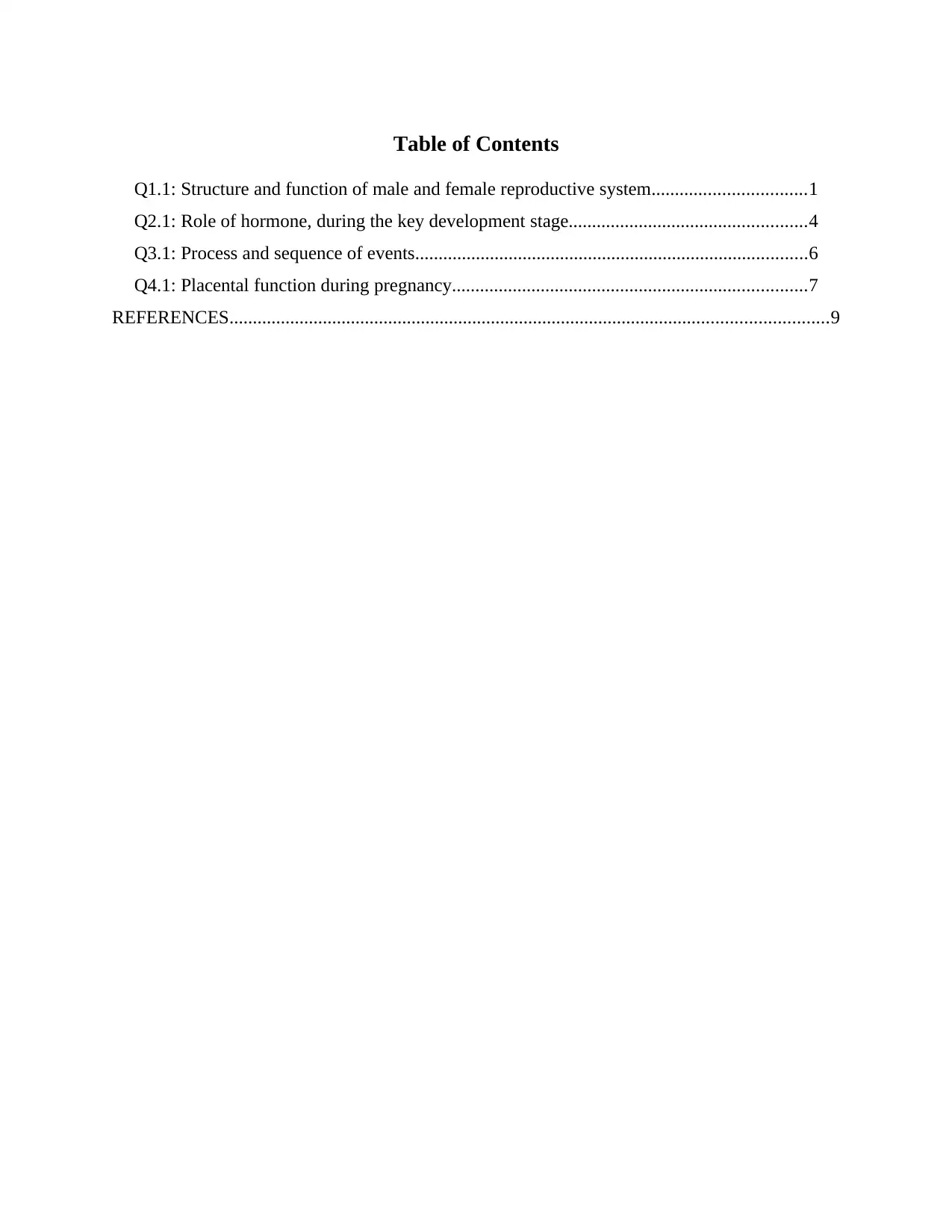
Table of Contents
Q1.1: Structure and function of male and female reproductive system.................................1
Q2.1: Role of hormone, during the key development stage...................................................4
Q3.1: Process and sequence of events....................................................................................6
Q4.1: Placental function during pregnancy............................................................................7
REFERENCES................................................................................................................................9
Q1.1: Structure and function of male and female reproductive system.................................1
Q2.1: Role of hormone, during the key development stage...................................................4
Q3.1: Process and sequence of events....................................................................................6
Q4.1: Placental function during pregnancy............................................................................7
REFERENCES................................................................................................................................9
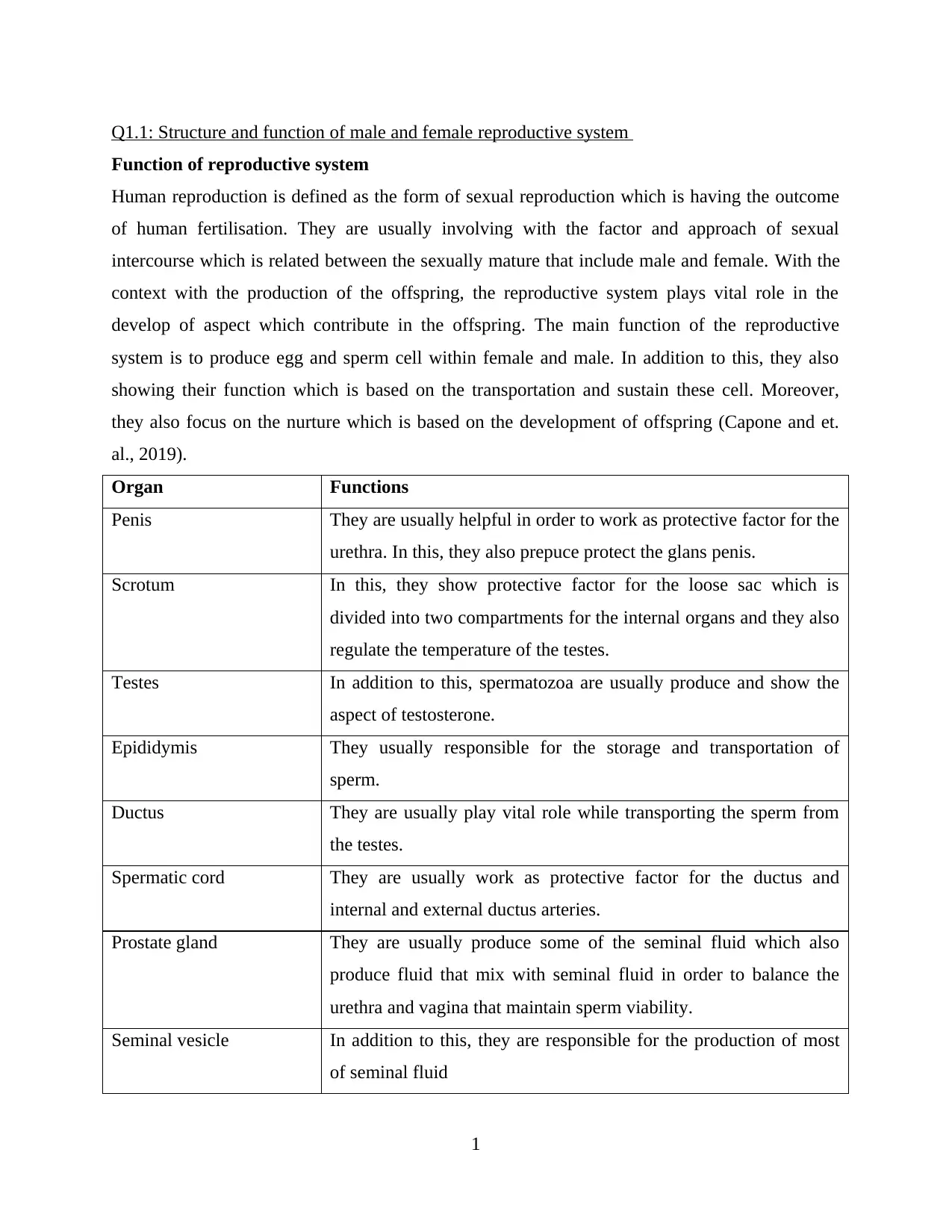
Q1.1: Structure and function of male and female reproductive system
Function of reproductive system
Human reproduction is defined as the form of sexual reproduction which is having the outcome
of human fertilisation. They are usually involving with the factor and approach of sexual
intercourse which is related between the sexually mature that include male and female. With the
context with the production of the offspring, the reproductive system plays vital role in the
develop of aspect which contribute in the offspring. The main function of the reproductive
system is to produce egg and sperm cell within female and male. In addition to this, they also
showing their function which is based on the transportation and sustain these cell. Moreover,
they also focus on the nurture which is based on the development of offspring (Capone and et.
al., 2019).
Organ Functions
Penis They are usually helpful in order to work as protective factor for the
urethra. In this, they also prepuce protect the glans penis.
Scrotum In this, they show protective factor for the loose sac which is
divided into two compartments for the internal organs and they also
regulate the temperature of the testes.
Testes In addition to this, spermatozoa are usually produce and show the
aspect of testosterone.
Epididymis They usually responsible for the storage and transportation of
sperm.
Ductus They are usually play vital role while transporting the sperm from
the testes.
Spermatic cord They are usually work as protective factor for the ductus and
internal and external ductus arteries.
Prostate gland They are usually produce some of the seminal fluid which also
produce fluid that mix with seminal fluid in order to balance the
urethra and vagina that maintain sperm viability.
Seminal vesicle In addition to this, they are responsible for the production of most
of seminal fluid
1
Function of reproductive system
Human reproduction is defined as the form of sexual reproduction which is having the outcome
of human fertilisation. They are usually involving with the factor and approach of sexual
intercourse which is related between the sexually mature that include male and female. With the
context with the production of the offspring, the reproductive system plays vital role in the
develop of aspect which contribute in the offspring. The main function of the reproductive
system is to produce egg and sperm cell within female and male. In addition to this, they also
showing their function which is based on the transportation and sustain these cell. Moreover,
they also focus on the nurture which is based on the development of offspring (Capone and et.
al., 2019).
Organ Functions
Penis They are usually helpful in order to work as protective factor for the
urethra. In this, they also prepuce protect the glans penis.
Scrotum In this, they show protective factor for the loose sac which is
divided into two compartments for the internal organs and they also
regulate the temperature of the testes.
Testes In addition to this, spermatozoa are usually produce and show the
aspect of testosterone.
Epididymis They usually responsible for the storage and transportation of
sperm.
Ductus They are usually play vital role while transporting the sperm from
the testes.
Spermatic cord They are usually work as protective factor for the ductus and
internal and external ductus arteries.
Prostate gland They are usually produce some of the seminal fluid which also
produce fluid that mix with seminal fluid in order to balance the
urethra and vagina that maintain sperm viability.
Seminal vesicle In addition to this, they are responsible for the production of most
of seminal fluid
1
⊘ This is a preview!⊘
Do you want full access?
Subscribe today to unlock all pages.

Trusted by 1+ million students worldwide
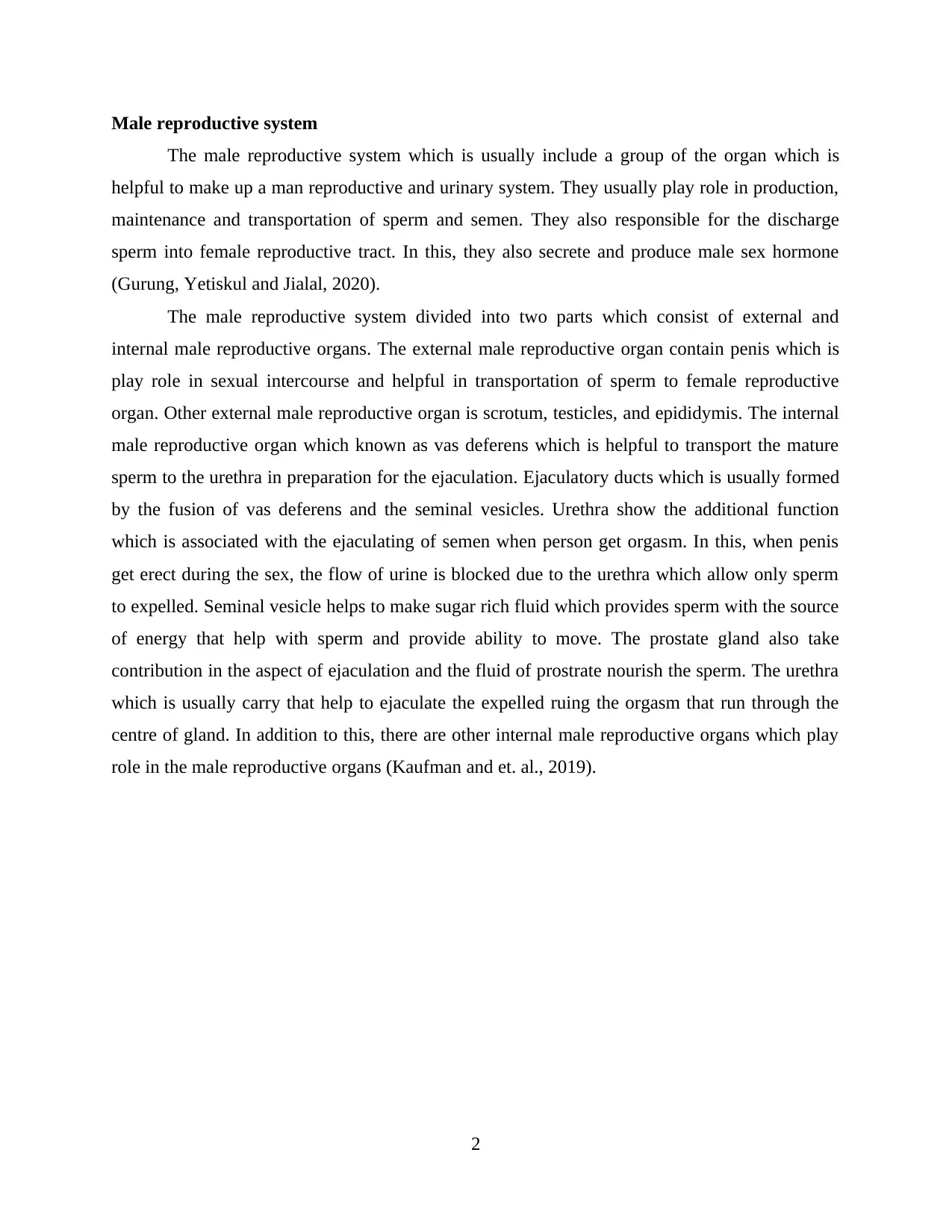
Male reproductive system
The male reproductive system which is usually include a group of the organ which is
helpful to make up a man reproductive and urinary system. They usually play role in production,
maintenance and transportation of sperm and semen. They also responsible for the discharge
sperm into female reproductive tract. In this, they also secrete and produce male sex hormone
(Gurung, Yetiskul and Jialal, 2020).
The male reproductive system divided into two parts which consist of external and
internal male reproductive organs. The external male reproductive organ contain penis which is
play role in sexual intercourse and helpful in transportation of sperm to female reproductive
organ. Other external male reproductive organ is scrotum, testicles, and epididymis. The internal
male reproductive organ which known as vas deferens which is helpful to transport the mature
sperm to the urethra in preparation for the ejaculation. Ejaculatory ducts which is usually formed
by the fusion of vas deferens and the seminal vesicles. Urethra show the additional function
which is associated with the ejaculating of semen when person get orgasm. In this, when penis
get erect during the sex, the flow of urine is blocked due to the urethra which allow only sperm
to expelled. Seminal vesicle helps to make sugar rich fluid which provides sperm with the source
of energy that help with sperm and provide ability to move. The prostate gland also take
contribution in the aspect of ejaculation and the fluid of prostrate nourish the sperm. The urethra
which is usually carry that help to ejaculate the expelled ruing the orgasm that run through the
centre of gland. In addition to this, there are other internal male reproductive organs which play
role in the male reproductive organs (Kaufman and et. al., 2019).
2
The male reproductive system which is usually include a group of the organ which is
helpful to make up a man reproductive and urinary system. They usually play role in production,
maintenance and transportation of sperm and semen. They also responsible for the discharge
sperm into female reproductive tract. In this, they also secrete and produce male sex hormone
(Gurung, Yetiskul and Jialal, 2020).
The male reproductive system divided into two parts which consist of external and
internal male reproductive organs. The external male reproductive organ contain penis which is
play role in sexual intercourse and helpful in transportation of sperm to female reproductive
organ. Other external male reproductive organ is scrotum, testicles, and epididymis. The internal
male reproductive organ which known as vas deferens which is helpful to transport the mature
sperm to the urethra in preparation for the ejaculation. Ejaculatory ducts which is usually formed
by the fusion of vas deferens and the seminal vesicles. Urethra show the additional function
which is associated with the ejaculating of semen when person get orgasm. In this, when penis
get erect during the sex, the flow of urine is blocked due to the urethra which allow only sperm
to expelled. Seminal vesicle helps to make sugar rich fluid which provides sperm with the source
of energy that help with sperm and provide ability to move. The prostate gland also take
contribution in the aspect of ejaculation and the fluid of prostrate nourish the sperm. The urethra
which is usually carry that help to ejaculate the expelled ruing the orgasm that run through the
centre of gland. In addition to this, there are other internal male reproductive organs which play
role in the male reproductive organs (Kaufman and et. al., 2019).
2
Paraphrase This Document
Need a fresh take? Get an instant paraphrase of this document with our AI Paraphraser
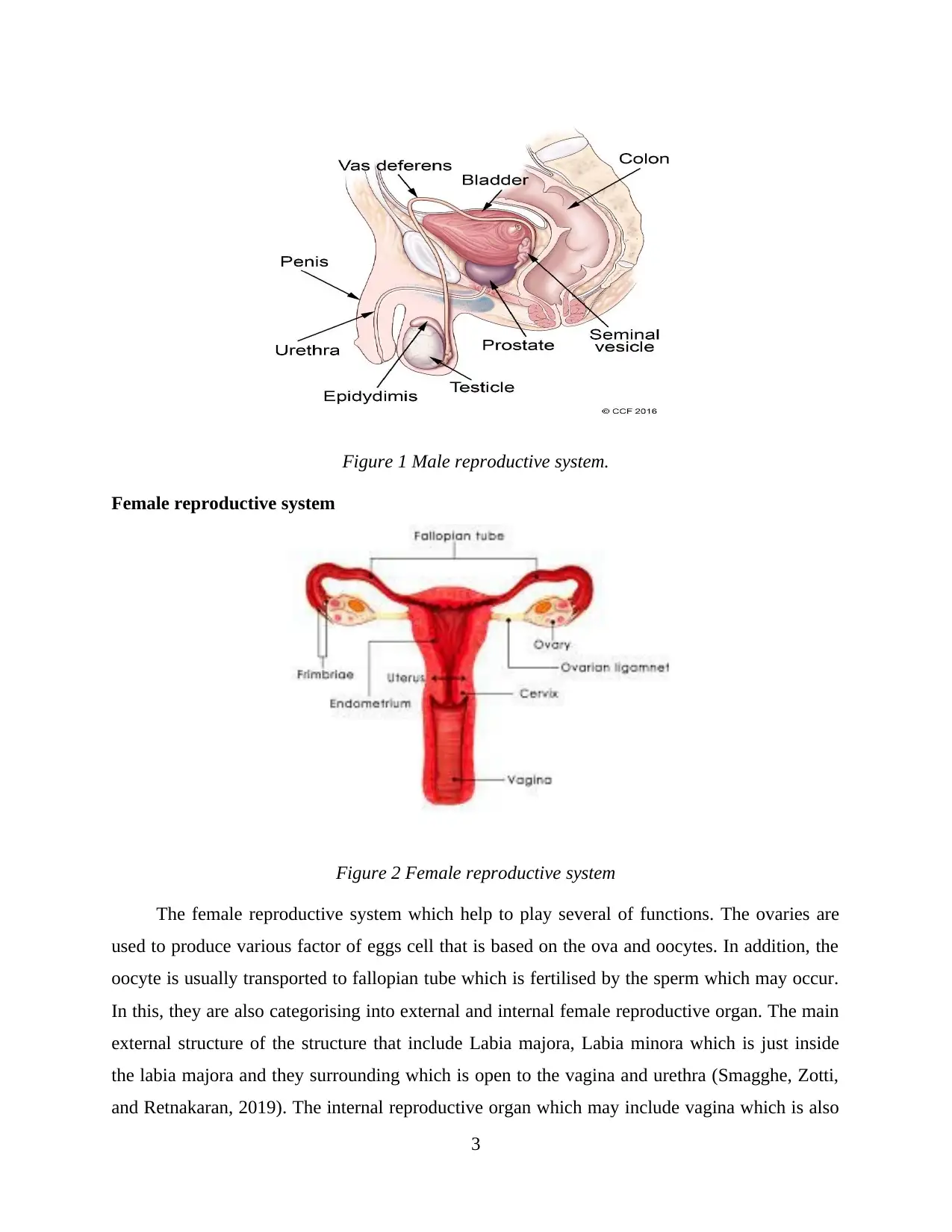
Figure 1 Male reproductive system.
Female reproductive system
Figure 2 Female reproductive system
The female reproductive system which help to play several of functions. The ovaries are
used to produce various factor of eggs cell that is based on the ova and oocytes. In addition, the
oocyte is usually transported to fallopian tube which is fertilised by the sperm which may occur.
In this, they are also categorising into external and internal female reproductive organ. The main
external structure of the structure that include Labia majora, Labia minora which is just inside
the labia majora and they surrounding which is open to the vagina and urethra (Smagghe, Zotti,
and Retnakaran, 2019). The internal reproductive organ which may include vagina which is also
3
Female reproductive system
Figure 2 Female reproductive system
The female reproductive system which help to play several of functions. The ovaries are
used to produce various factor of eggs cell that is based on the ova and oocytes. In addition, the
oocyte is usually transported to fallopian tube which is fertilised by the sperm which may occur.
In this, they are also categorising into external and internal female reproductive organ. The main
external structure of the structure that include Labia majora, Labia minora which is just inside
the labia majora and they surrounding which is open to the vagina and urethra (Smagghe, Zotti,
and Retnakaran, 2019). The internal reproductive organ which may include vagina which is also
3
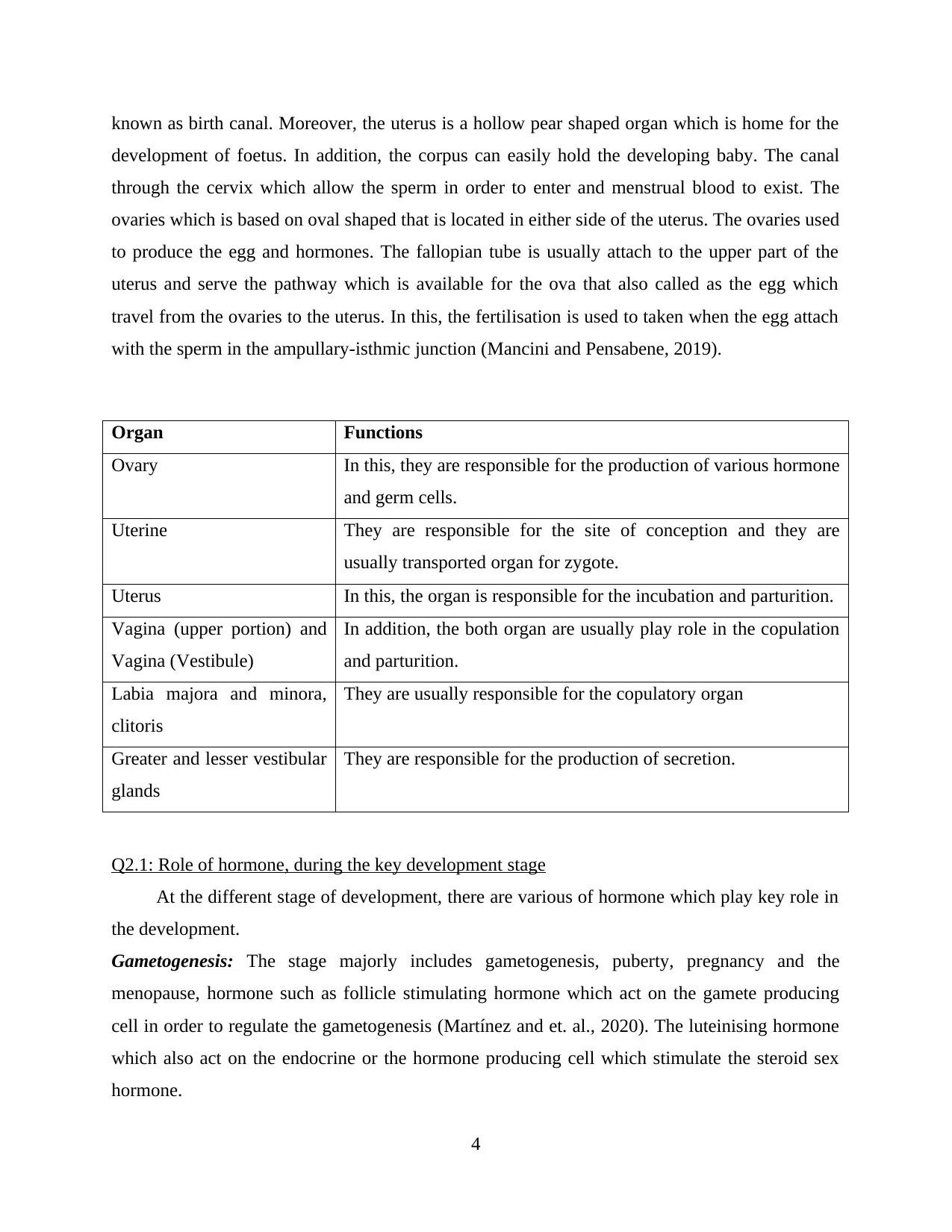
known as birth canal. Moreover, the uterus is a hollow pear shaped organ which is home for the
development of foetus. In addition, the corpus can easily hold the developing baby. The canal
through the cervix which allow the sperm in order to enter and menstrual blood to exist. The
ovaries which is based on oval shaped that is located in either side of the uterus. The ovaries used
to produce the egg and hormones. The fallopian tube is usually attach to the upper part of the
uterus and serve the pathway which is available for the ova that also called as the egg which
travel from the ovaries to the uterus. In this, the fertilisation is used to taken when the egg attach
with the sperm in the ampullary-isthmic junction (Mancini and Pensabene, 2019).
Organ Functions
Ovary In this, they are responsible for the production of various hormone
and germ cells.
Uterine They are responsible for the site of conception and they are
usually transported organ for zygote.
Uterus In this, the organ is responsible for the incubation and parturition.
Vagina (upper portion) and
Vagina (Vestibule)
In addition, the both organ are usually play role in the copulation
and parturition.
Labia majora and minora,
clitoris
They are usually responsible for the copulatory organ
Greater and lesser vestibular
glands
They are responsible for the production of secretion.
Q2.1: Role of hormone, during the key development stage
At the different stage of development, there are various of hormone which play key role in
the development.
Gametogenesis: The stage majorly includes gametogenesis, puberty, pregnancy and the
menopause, hormone such as follicle stimulating hormone which act on the gamete producing
cell in order to regulate the gametogenesis (Martínez and et. al., 2020). The luteinising hormone
which also act on the endocrine or the hormone producing cell which stimulate the steroid sex
hormone.
4
development of foetus. In addition, the corpus can easily hold the developing baby. The canal
through the cervix which allow the sperm in order to enter and menstrual blood to exist. The
ovaries which is based on oval shaped that is located in either side of the uterus. The ovaries used
to produce the egg and hormones. The fallopian tube is usually attach to the upper part of the
uterus and serve the pathway which is available for the ova that also called as the egg which
travel from the ovaries to the uterus. In this, the fertilisation is used to taken when the egg attach
with the sperm in the ampullary-isthmic junction (Mancini and Pensabene, 2019).
Organ Functions
Ovary In this, they are responsible for the production of various hormone
and germ cells.
Uterine They are responsible for the site of conception and they are
usually transported organ for zygote.
Uterus In this, the organ is responsible for the incubation and parturition.
Vagina (upper portion) and
Vagina (Vestibule)
In addition, the both organ are usually play role in the copulation
and parturition.
Labia majora and minora,
clitoris
They are usually responsible for the copulatory organ
Greater and lesser vestibular
glands
They are responsible for the production of secretion.
Q2.1: Role of hormone, during the key development stage
At the different stage of development, there are various of hormone which play key role in
the development.
Gametogenesis: The stage majorly includes gametogenesis, puberty, pregnancy and the
menopause, hormone such as follicle stimulating hormone which act on the gamete producing
cell in order to regulate the gametogenesis (Martínez and et. al., 2020). The luteinising hormone
which also act on the endocrine or the hormone producing cell which stimulate the steroid sex
hormone.
4
⊘ This is a preview!⊘
Do you want full access?
Subscribe today to unlock all pages.

Trusted by 1+ million students worldwide
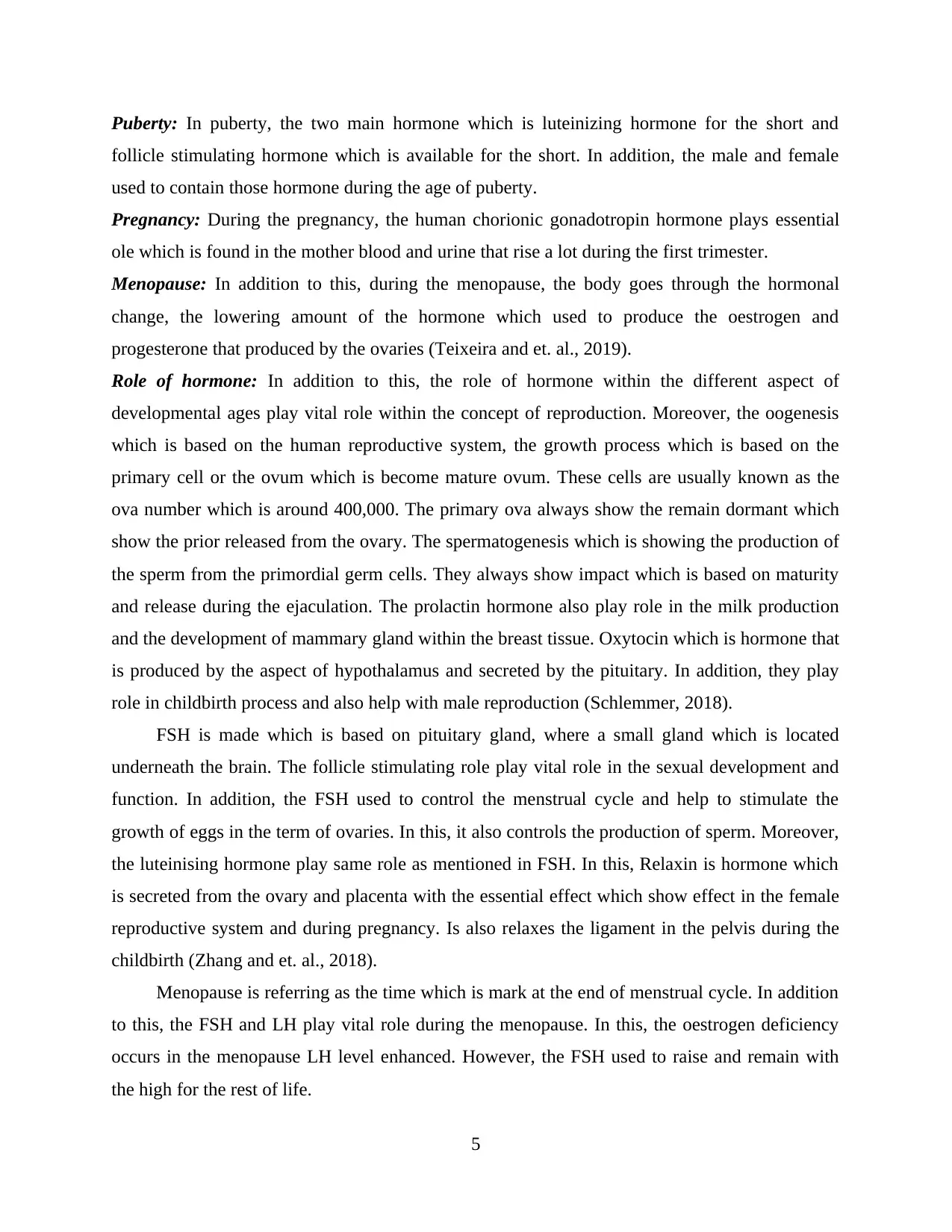
Puberty: In puberty, the two main hormone which is luteinizing hormone for the short and
follicle stimulating hormone which is available for the short. In addition, the male and female
used to contain those hormone during the age of puberty.
Pregnancy: During the pregnancy, the human chorionic gonadotropin hormone plays essential
ole which is found in the mother blood and urine that rise a lot during the first trimester.
Menopause: In addition to this, during the menopause, the body goes through the hormonal
change, the lowering amount of the hormone which used to produce the oestrogen and
progesterone that produced by the ovaries (Teixeira and et. al., 2019).
Role of hormone: In addition to this, the role of hormone within the different aspect of
developmental ages play vital role within the concept of reproduction. Moreover, the oogenesis
which is based on the human reproductive system, the growth process which is based on the
primary cell or the ovum which is become mature ovum. These cells are usually known as the
ova number which is around 400,000. The primary ova always show the remain dormant which
show the prior released from the ovary. The spermatogenesis which is showing the production of
the sperm from the primordial germ cells. They always show impact which is based on maturity
and release during the ejaculation. The prolactin hormone also play role in the milk production
and the development of mammary gland within the breast tissue. Oxytocin which is hormone that
is produced by the aspect of hypothalamus and secreted by the pituitary. In addition, they play
role in childbirth process and also help with male reproduction (Schlemmer, 2018).
FSH is made which is based on pituitary gland, where a small gland which is located
underneath the brain. The follicle stimulating role play vital role in the sexual development and
function. In addition, the FSH used to control the menstrual cycle and help to stimulate the
growth of eggs in the term of ovaries. In this, it also controls the production of sperm. Moreover,
the luteinising hormone play same role as mentioned in FSH. In this, Relaxin is hormone which
is secreted from the ovary and placenta with the essential effect which show effect in the female
reproductive system and during pregnancy. Is also relaxes the ligament in the pelvis during the
childbirth (Zhang and et. al., 2018).
Menopause is referring as the time which is mark at the end of menstrual cycle. In addition
to this, the FSH and LH play vital role during the menopause. In this, the oestrogen deficiency
occurs in the menopause LH level enhanced. However, the FSH used to raise and remain with
the high for the rest of life.
5
follicle stimulating hormone which is available for the short. In addition, the male and female
used to contain those hormone during the age of puberty.
Pregnancy: During the pregnancy, the human chorionic gonadotropin hormone plays essential
ole which is found in the mother blood and urine that rise a lot during the first trimester.
Menopause: In addition to this, during the menopause, the body goes through the hormonal
change, the lowering amount of the hormone which used to produce the oestrogen and
progesterone that produced by the ovaries (Teixeira and et. al., 2019).
Role of hormone: In addition to this, the role of hormone within the different aspect of
developmental ages play vital role within the concept of reproduction. Moreover, the oogenesis
which is based on the human reproductive system, the growth process which is based on the
primary cell or the ovum which is become mature ovum. These cells are usually known as the
ova number which is around 400,000. The primary ova always show the remain dormant which
show the prior released from the ovary. The spermatogenesis which is showing the production of
the sperm from the primordial germ cells. They always show impact which is based on maturity
and release during the ejaculation. The prolactin hormone also play role in the milk production
and the development of mammary gland within the breast tissue. Oxytocin which is hormone that
is produced by the aspect of hypothalamus and secreted by the pituitary. In addition, they play
role in childbirth process and also help with male reproduction (Schlemmer, 2018).
FSH is made which is based on pituitary gland, where a small gland which is located
underneath the brain. The follicle stimulating role play vital role in the sexual development and
function. In addition, the FSH used to control the menstrual cycle and help to stimulate the
growth of eggs in the term of ovaries. In this, it also controls the production of sperm. Moreover,
the luteinising hormone play same role as mentioned in FSH. In this, Relaxin is hormone which
is secreted from the ovary and placenta with the essential effect which show effect in the female
reproductive system and during pregnancy. Is also relaxes the ligament in the pelvis during the
childbirth (Zhang and et. al., 2018).
Menopause is referring as the time which is mark at the end of menstrual cycle. In addition
to this, the FSH and LH play vital role during the menopause. In this, the oestrogen deficiency
occurs in the menopause LH level enhanced. However, the FSH used to raise and remain with
the high for the rest of life.
5
Paraphrase This Document
Need a fresh take? Get an instant paraphrase of this document with our AI Paraphraser
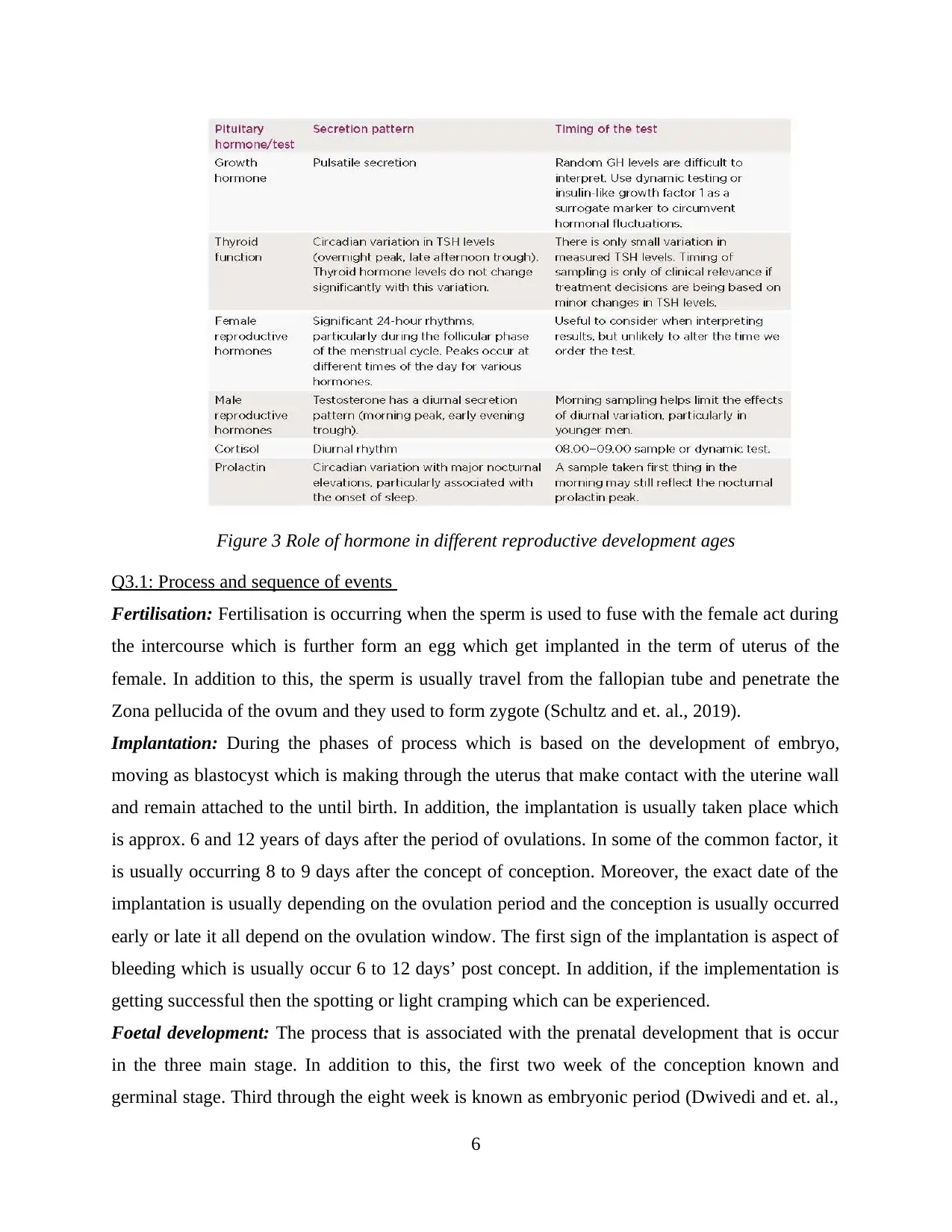
Figure 3 Role of hormone in different reproductive development ages
Q3.1: Process and sequence of events
Fertilisation: Fertilisation is occurring when the sperm is used to fuse with the female act during
the intercourse which is further form an egg which get implanted in the term of uterus of the
female. In addition to this, the sperm is usually travel from the fallopian tube and penetrate the
Zona pellucida of the ovum and they used to form zygote (Schultz and et. al., 2019).
Implantation: During the phases of process which is based on the development of embryo,
moving as blastocyst which is making through the uterus that make contact with the uterine wall
and remain attached to the until birth. In addition, the implantation is usually taken place which
is approx. 6 and 12 years of days after the period of ovulations. In some of the common factor, it
is usually occurring 8 to 9 days after the concept of conception. Moreover, the exact date of the
implantation is usually depending on the ovulation period and the conception is usually occurred
early or late it all depend on the ovulation window. The first sign of the implantation is aspect of
bleeding which is usually occur 6 to 12 days’ post concept. In addition, if the implementation is
getting successful then the spotting or light cramping which can be experienced.
Foetal development: The process that is associated with the prenatal development that is occur
in the three main stage. In addition to this, the first two week of the conception known and
germinal stage. Third through the eight week is known as embryonic period (Dwivedi and et. al.,
6
Q3.1: Process and sequence of events
Fertilisation: Fertilisation is occurring when the sperm is used to fuse with the female act during
the intercourse which is further form an egg which get implanted in the term of uterus of the
female. In addition to this, the sperm is usually travel from the fallopian tube and penetrate the
Zona pellucida of the ovum and they used to form zygote (Schultz and et. al., 2019).
Implantation: During the phases of process which is based on the development of embryo,
moving as blastocyst which is making through the uterus that make contact with the uterine wall
and remain attached to the until birth. In addition, the implantation is usually taken place which
is approx. 6 and 12 years of days after the period of ovulations. In some of the common factor, it
is usually occurring 8 to 9 days after the concept of conception. Moreover, the exact date of the
implantation is usually depending on the ovulation period and the conception is usually occurred
early or late it all depend on the ovulation window. The first sign of the implantation is aspect of
bleeding which is usually occur 6 to 12 days’ post concept. In addition, if the implementation is
getting successful then the spotting or light cramping which can be experienced.
Foetal development: The process that is associated with the prenatal development that is occur
in the three main stage. In addition to this, the first two week of the conception known and
germinal stage. Third through the eight week is known as embryonic period (Dwivedi and et. al.,
6
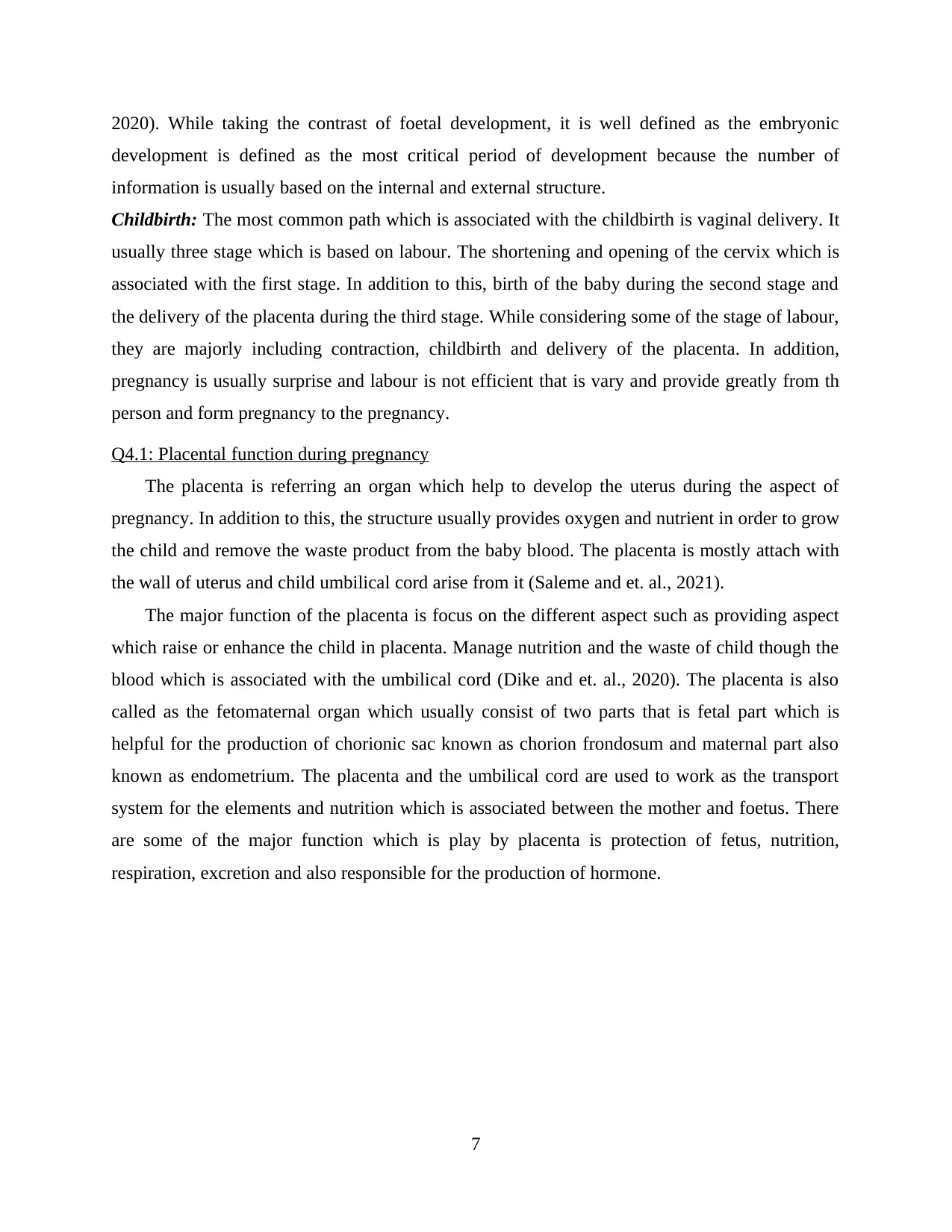
2020). While taking the contrast of foetal development, it is well defined as the embryonic
development is defined as the most critical period of development because the number of
information is usually based on the internal and external structure.
Childbirth: The most common path which is associated with the childbirth is vaginal delivery. It
usually three stage which is based on labour. The shortening and opening of the cervix which is
associated with the first stage. In addition to this, birth of the baby during the second stage and
the delivery of the placenta during the third stage. While considering some of the stage of labour,
they are majorly including contraction, childbirth and delivery of the placenta. In addition,
pregnancy is usually surprise and labour is not efficient that is vary and provide greatly from th
person and form pregnancy to the pregnancy.
Q4.1: Placental function during pregnancy
The placenta is referring an organ which help to develop the uterus during the aspect of
pregnancy. In addition to this, the structure usually provides oxygen and nutrient in order to grow
the child and remove the waste product from the baby blood. The placenta is mostly attach with
the wall of uterus and child umbilical cord arise from it (Saleme and et. al., 2021).
The major function of the placenta is focus on the different aspect such as providing aspect
which raise or enhance the child in placenta. Manage nutrition and the waste of child though the
blood which is associated with the umbilical cord (Dike and et. al., 2020). The placenta is also
called as the fetomaternal organ which usually consist of two parts that is fetal part which is
helpful for the production of chorionic sac known as chorion frondosum and maternal part also
known as endometrium. The placenta and the umbilical cord are used to work as the transport
system for the elements and nutrition which is associated between the mother and foetus. There
are some of the major function which is play by placenta is protection of fetus, nutrition,
respiration, excretion and also responsible for the production of hormone.
7
development is defined as the most critical period of development because the number of
information is usually based on the internal and external structure.
Childbirth: The most common path which is associated with the childbirth is vaginal delivery. It
usually three stage which is based on labour. The shortening and opening of the cervix which is
associated with the first stage. In addition to this, birth of the baby during the second stage and
the delivery of the placenta during the third stage. While considering some of the stage of labour,
they are majorly including contraction, childbirth and delivery of the placenta. In addition,
pregnancy is usually surprise and labour is not efficient that is vary and provide greatly from th
person and form pregnancy to the pregnancy.
Q4.1: Placental function during pregnancy
The placenta is referring an organ which help to develop the uterus during the aspect of
pregnancy. In addition to this, the structure usually provides oxygen and nutrient in order to grow
the child and remove the waste product from the baby blood. The placenta is mostly attach with
the wall of uterus and child umbilical cord arise from it (Saleme and et. al., 2021).
The major function of the placenta is focus on the different aspect such as providing aspect
which raise or enhance the child in placenta. Manage nutrition and the waste of child though the
blood which is associated with the umbilical cord (Dike and et. al., 2020). The placenta is also
called as the fetomaternal organ which usually consist of two parts that is fetal part which is
helpful for the production of chorionic sac known as chorion frondosum and maternal part also
known as endometrium. The placenta and the umbilical cord are used to work as the transport
system for the elements and nutrition which is associated between the mother and foetus. There
are some of the major function which is play by placenta is protection of fetus, nutrition,
respiration, excretion and also responsible for the production of hormone.
7
⊘ This is a preview!⊘
Do you want full access?
Subscribe today to unlock all pages.

Trusted by 1+ million students worldwide
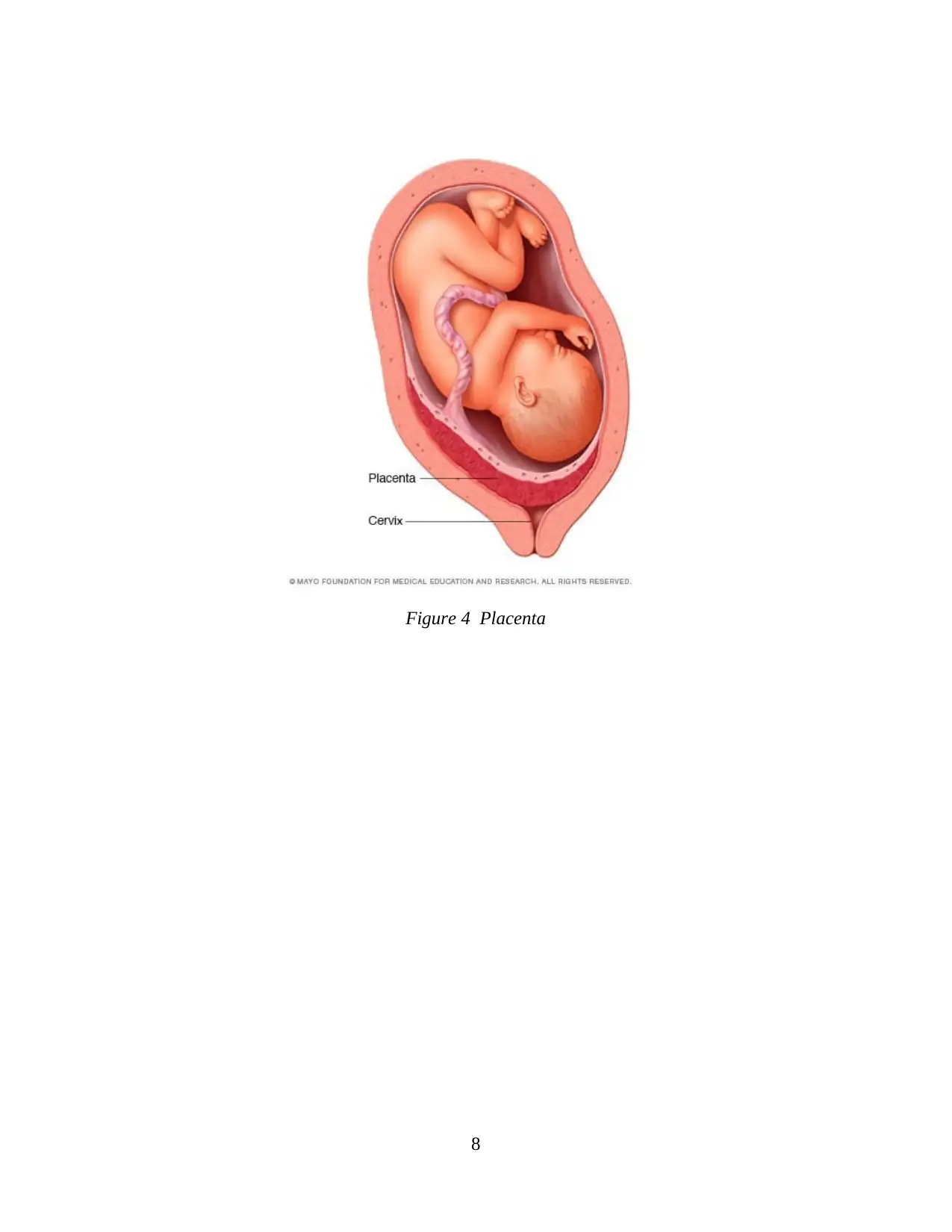
Figure 4 Placenta
8
8
Paraphrase This Document
Need a fresh take? Get an instant paraphrase of this document with our AI Paraphraser
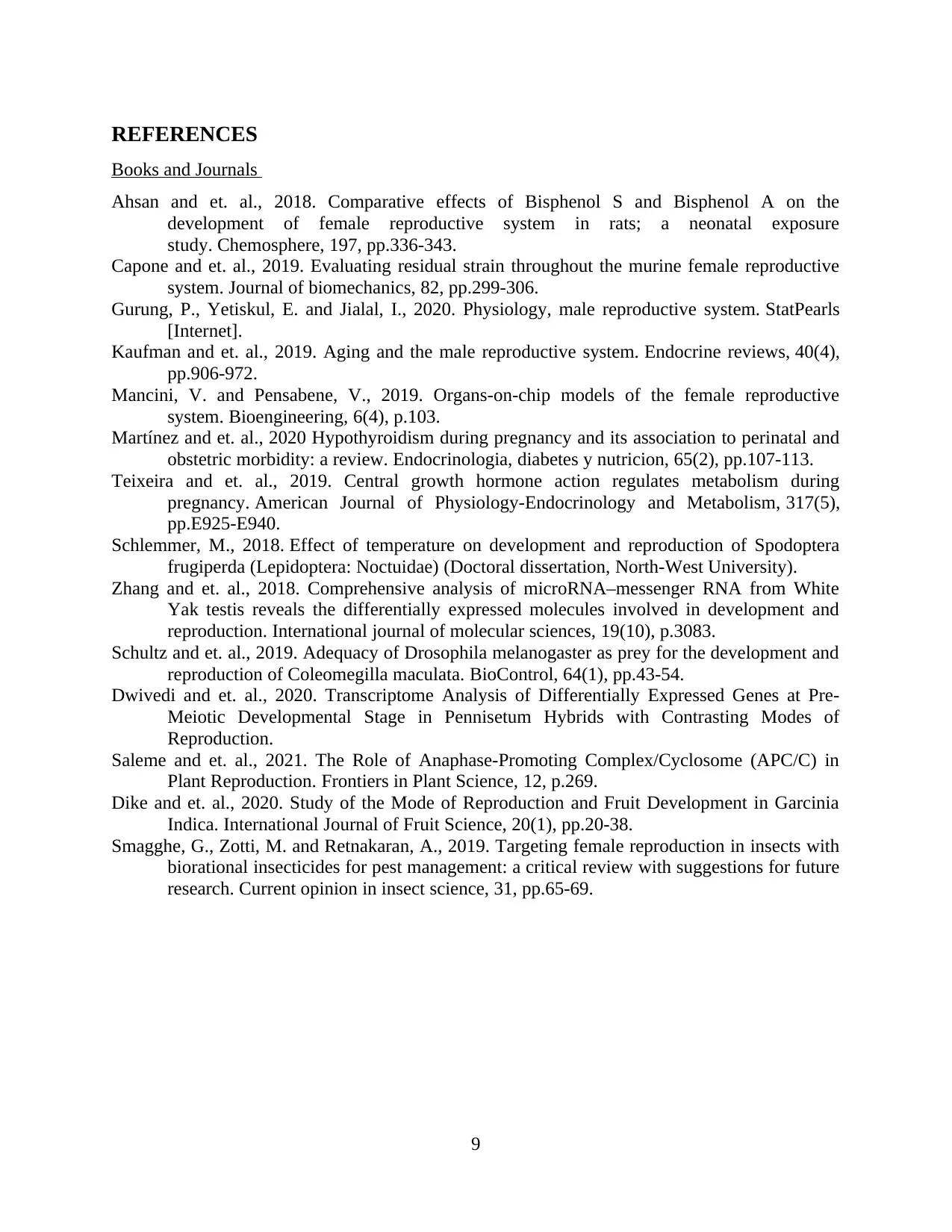
REFERENCES
Books and Journals
Ahsan and et. al., 2018. Comparative effects of Bisphenol S and Bisphenol A on the
development of female reproductive system in rats; a neonatal exposure
study. Chemosphere, 197, pp.336-343.
Capone and et. al., 2019. Evaluating residual strain throughout the murine female reproductive
system. Journal of biomechanics, 82, pp.299-306.
Gurung, P., Yetiskul, E. and Jialal, I., 2020. Physiology, male reproductive system. StatPearls
[Internet].
Kaufman and et. al., 2019. Aging and the male reproductive system. Endocrine reviews, 40(4),
pp.906-972.
Mancini, V. and Pensabene, V., 2019. Organs-on-chip models of the female reproductive
system. Bioengineering, 6(4), p.103.
Martínez and et. al., 2020 Hypothyroidism during pregnancy and its association to perinatal and
obstetric morbidity: a review. Endocrinologia, diabetes y nutricion, 65(2), pp.107-113.
Teixeira and et. al., 2019. Central growth hormone action regulates metabolism during
pregnancy. American Journal of Physiology-Endocrinology and Metabolism, 317(5),
pp.E925-E940.
Schlemmer, M., 2018. Effect of temperature on development and reproduction of Spodoptera
frugiperda (Lepidoptera: Noctuidae) (Doctoral dissertation, North-West University).
Zhang and et. al., 2018. Comprehensive analysis of microRNA–messenger RNA from White
Yak testis reveals the differentially expressed molecules involved in development and
reproduction. International journal of molecular sciences, 19(10), p.3083.
Schultz and et. al., 2019. Adequacy of Drosophila melanogaster as prey for the development and
reproduction of Coleomegilla maculata. BioControl, 64(1), pp.43-54.
Dwivedi and et. al., 2020. Transcriptome Analysis of Differentially Expressed Genes at Pre-
Meiotic Developmental Stage in Pennisetum Hybrids with Contrasting Modes of
Reproduction.
Saleme and et. al., 2021. The Role of Anaphase-Promoting Complex/Cyclosome (APC/C) in
Plant Reproduction. Frontiers in Plant Science, 12, p.269.
Dike and et. al., 2020. Study of the Mode of Reproduction and Fruit Development in Garcinia
Indica. International Journal of Fruit Science, 20(1), pp.20-38.
Smagghe, G., Zotti, M. and Retnakaran, A., 2019. Targeting female reproduction in insects with
biorational insecticides for pest management: a critical review with suggestions for future
research. Current opinion in insect science, 31, pp.65-69.
9
Books and Journals
Ahsan and et. al., 2018. Comparative effects of Bisphenol S and Bisphenol A on the
development of female reproductive system in rats; a neonatal exposure
study. Chemosphere, 197, pp.336-343.
Capone and et. al., 2019. Evaluating residual strain throughout the murine female reproductive
system. Journal of biomechanics, 82, pp.299-306.
Gurung, P., Yetiskul, E. and Jialal, I., 2020. Physiology, male reproductive system. StatPearls
[Internet].
Kaufman and et. al., 2019. Aging and the male reproductive system. Endocrine reviews, 40(4),
pp.906-972.
Mancini, V. and Pensabene, V., 2019. Organs-on-chip models of the female reproductive
system. Bioengineering, 6(4), p.103.
Martínez and et. al., 2020 Hypothyroidism during pregnancy and its association to perinatal and
obstetric morbidity: a review. Endocrinologia, diabetes y nutricion, 65(2), pp.107-113.
Teixeira and et. al., 2019. Central growth hormone action regulates metabolism during
pregnancy. American Journal of Physiology-Endocrinology and Metabolism, 317(5),
pp.E925-E940.
Schlemmer, M., 2018. Effect of temperature on development and reproduction of Spodoptera
frugiperda (Lepidoptera: Noctuidae) (Doctoral dissertation, North-West University).
Zhang and et. al., 2018. Comprehensive analysis of microRNA–messenger RNA from White
Yak testis reveals the differentially expressed molecules involved in development and
reproduction. International journal of molecular sciences, 19(10), p.3083.
Schultz and et. al., 2019. Adequacy of Drosophila melanogaster as prey for the development and
reproduction of Coleomegilla maculata. BioControl, 64(1), pp.43-54.
Dwivedi and et. al., 2020. Transcriptome Analysis of Differentially Expressed Genes at Pre-
Meiotic Developmental Stage in Pennisetum Hybrids with Contrasting Modes of
Reproduction.
Saleme and et. al., 2021. The Role of Anaphase-Promoting Complex/Cyclosome (APC/C) in
Plant Reproduction. Frontiers in Plant Science, 12, p.269.
Dike and et. al., 2020. Study of the Mode of Reproduction and Fruit Development in Garcinia
Indica. International Journal of Fruit Science, 20(1), pp.20-38.
Smagghe, G., Zotti, M. and Retnakaran, A., 2019. Targeting female reproduction in insects with
biorational insecticides for pest management: a critical review with suggestions for future
research. Current opinion in insect science, 31, pp.65-69.
9

10
⊘ This is a preview!⊘
Do you want full access?
Subscribe today to unlock all pages.

Trusted by 1+ million students worldwide
1 out of 12
Related Documents
Your All-in-One AI-Powered Toolkit for Academic Success.
+13062052269
info@desklib.com
Available 24*7 on WhatsApp / Email
![[object Object]](/_next/static/media/star-bottom.7253800d.svg)
Unlock your academic potential
Copyright © 2020–2025 A2Z Services. All Rights Reserved. Developed and managed by ZUCOL.




